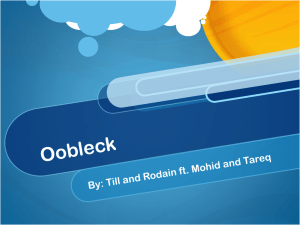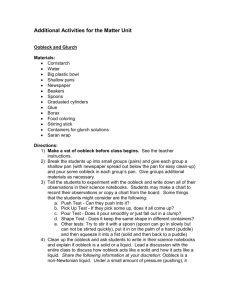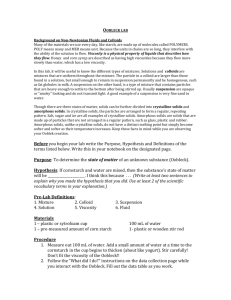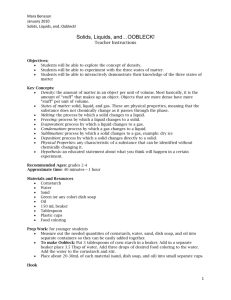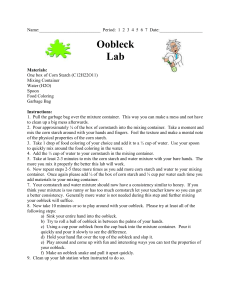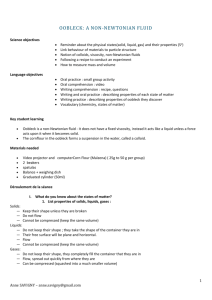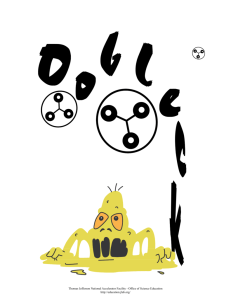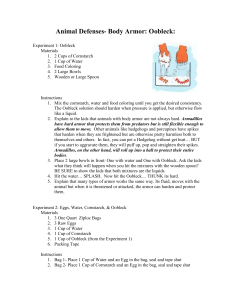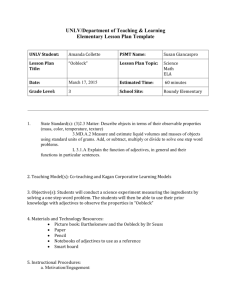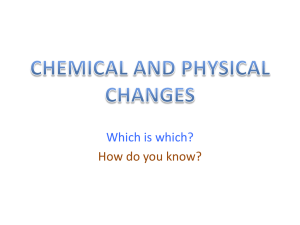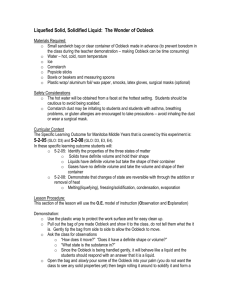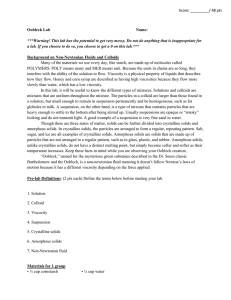Properties of Matter Lesson Plan
advertisement
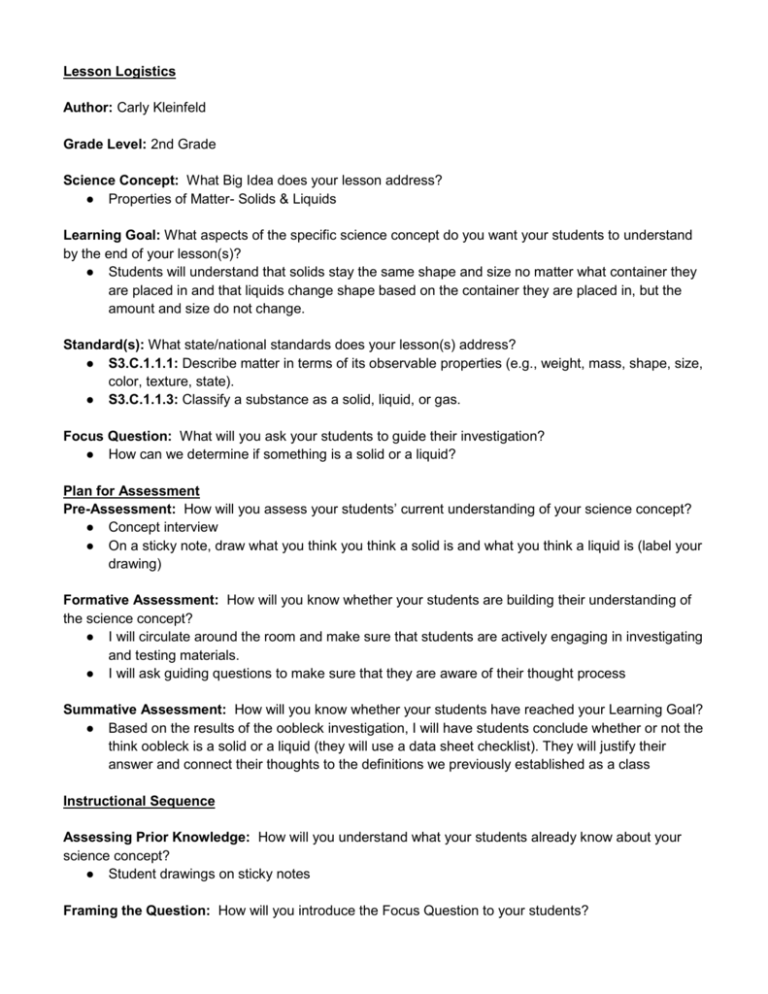
Lesson Logistics Author: Carly Kleinfeld Grade Level: 2nd Grade Science Concept: What Big Idea does your lesson address? ● Properties of Matter- Solids & Liquids Learning Goal: What aspects of the specific science concept do you want your students to understand by the end of your lesson(s)? ● Students will understand that solids stay the same shape and size no matter what container they are placed in and that liquids change shape based on the container they are placed in, but the amount and size do not change. Standard(s): What state/national standards does your lesson(s) address? ● S3.C.1.1.1: Describe matter in terms of its observable properties (e.g., weight, mass, shape, size, color, texture, state). ● S3.C.1.1.3: Classify a substance as a solid, liquid, or gas. Focus Question: What will you ask your students to guide their investigation? ● How can we determine if something is a solid or a liquid? Plan for Assessment Pre-Assessment: How will you assess your students’ current understanding of your science concept? ● Concept interview ● On a sticky note, draw what you think you think a solid is and what you think a liquid is (label your drawing) Formative Assessment: How will you know whether your students are building their understanding of the science concept? ● I will circulate around the room and make sure that students are actively engaging in investigating and testing materials. ● I will ask guiding questions to make sure that they are aware of their thought process Summative Assessment: How will you know whether your students have reached your Learning Goal? ● Based on the results of the oobleck investigation, I will have students conclude whether or not the think oobleck is a solid or a liquid (they will use a data sheet checklist). They will justify their answer and connect their thoughts to the definitions we previously established as a class Instructional Sequence Assessing Prior Knowledge: How will you understand what your students already know about your science concept? ● Student drawings on sticky notes Framing the Question: How will you introduce the Focus Question to your students? ● “As some of you may know, solids and liquids have different properties/ characteristics. Today we are going to investigate and define these two properties of matter. Once we define these properties, I will give you a substance to categorize as either a solid or liquid.” (After listing the defining characteristics of solids and liquids I will present students with the focus question) Making Predictions: Without any additional information, how would your students answer the Focus Question (depending on topic this may be the same as the pre-assessment). ● Read the book Bartholomew and the Oobleck” by Dr. Seuss (pre-select pages to be used) and have students make predictions on whether or not oobleck is a solid or liquid ● Do a demonstration punching and gently dipping fingers in the oobleck ● Students will be making predictions throughout the investigation through trial and error with various objects Gathering Data: What will your students be doing? What data will they gather? How will this data help them answer the Focus Question? ● Have students work in tables. Each table will test the same items and fill out the same data form ○ Items to be tested include: water, shampoo, honey, beans, pencils, and marbles *Students will share their findings with the class/ I can do a demonstration of all the items at the front of the class Constructing a Scientific Explanation: Draft a complete CER explanation addressing your Focus Question. Claim: Oobleck is a liquid Evidence: Oobleck takes the shape of its container but the size does not change (we found this out through experimenting with the oobleck and other liquids which all followed the same pattern) Plan for Science Talk How will you incorporate talk and sense making into your lesson? What Talk Moves do you anticipate being most helpful in leading students toward your Learning Goal? ● Revoicing: rotating around the room and repeating what the students are saying ● Restating peer explanation: ask students to repeat what their peers said ● Wait time: giving students time to wait and understand the big concepts Step-By-Step Procedure 1. Read Bartholomew and the Oobleck” by Dr. Seuss 2. Stop at stopping point 3. Punch oobleck “is this a solid or a liquid?” 4. Slowly dip fingers in “now do you think this is a solid or a liquid?” 5. After punching and picking up the oobleck have students write whether they think it is solid or liquid on a sticky note (pre assessment/ predictions) 6. Group the sticky notes that say solid together and group the sticky notes that say liquid 7. “We need to figure out how we determine if something is a solid or a liquid” 8. Pass out data sheet with predetermined items on it 9. Have students work in small groups to determine if the objects change shape and/or change size when placed in a container 10. Have students note this on their data sheet (write YES or NO) 11. Make a t-chart on the board (one side labeled changes shape and doesn’t change size and the other side labeled doesn’t change shape and doesn’t change size) 12. Call on students to share their answers for each object 13. Make a sticky note for each object and place it on the correct side of the t-chart 14. Once each object is addressed and sticky notes are placed accordingly, explain to students that X objects are liquids because they change shape but do not change size and all of Z objects are solid because they do not change shape and do not change size 15. Now we have to test the Oobleck! 16. Have students play with/pour the oobleck 17. Students will fill in the same chart for the oobleck 18. The class will determine if they want to put the sticky note on the solid or liquid side of the t-chart on the board 19. Claim and evidence - “We are claiming the oobleck is a liquid” - Ask the class what evidence they have to support this - “When we poured the liquid into the container, it changed shape but did not change size” - This follows the same pattern as the other liquids we previously tested 20. Go back to their predictions and explain how at the beginning there were varying opinions but after doing our experiment you were able to come to the conclusion that oobleck is a liquid AND, you also figured out what the definition of a solid is and what the definition of a liquid is *We were trying to figure out how to determine if something is a solid or a liquid and you did it! (Answers focus question) “You guys are awesome” “So smart” Materials: - Water - Honey (DO HONEY LAST) - Shampoo - Beans - Pencils - Marbles - 2 containers per table (one for solids one for liquids) - Cups - Data sheets (make on excel) - Sticky notes *Directions: Please write YES or NO in the boxes next to each object depending on the results from your groups experiment. Does its shape change? Does its size change? Water Pencil Marble Shampoo Beans Honey Oobleck
